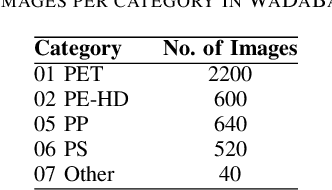Paresh Saxena
Application of Computer Vision Techniques for Segregation of PlasticWaste based on Resin Identification Code
Nov 16, 2020



Abstract:This paper presents methods to identify the plastic waste based on its resin identification code to provide an efficient recycling of post-consumer plastic waste. We propose the design, training and testing of different machine learning techniques to (i) identify a plastic waste that belongs to the known categories of plastic waste when the system is trained and (ii) identify a new plastic waste that do not belong the any known categories of plastic waste while the system is trained. For the first case,we propose the use of one-shot learning techniques using Siamese and Triplet loss networks. Our proposed approach does not require any augmentation to increase the size of the database and achieved a high accuracy of 99.74%. For the second case, we propose the use of supervised and unsupervised dimensionality reduction techniques and achieved an accuracy of 95% to correctly identify a new plastic waste.
One-Shot learning based classification for segregation of plastic waste
Sep 29, 2020



Abstract:The problem of segregating recyclable waste is fairly daunting for many countries. This article presents an approach for image based classification of plastic waste using one-shot learning techniques. The proposed approach exploits discriminative features generated via the siamese and triplet loss convolutional neural networks to help differentiate between 5 types of plastic waste based on their resin codes. The approach achieves an accuracy of 99.74% on the WaDaBa Database
NANCY: Neural Adaptive Network Coding methodologY for video distribution over wireless networks
Aug 21, 2020



Abstract:This paper presents NANCY, a system that generates adaptive bit rates (ABR) for video and adaptive network coding rates (ANCR) using reinforcement learning (RL) for video distribution over wireless networks. NANCY trains a neural network model with rewards formulated as quality of experience (QoE) metrics. It performs joint optimization in order to select: (i) adaptive bit rates for future video chunks to counter variations in available bandwidth and (ii) adaptive network coding rates to encode the video chunk slices to counter packet losses in wireless networks. We present the design and implementation of NANCY, and evaluate its performance compared to state-of-the-art video rate adaptation algorithms including Pensieve and robustMPC. Our results show that NANCY provides 29.91% and 60.34% higher average QoE than Pensieve and robustMPC, respectively.
 Add to Chrome
Add to Chrome Add to Firefox
Add to Firefox Add to Edge
Add to Edge